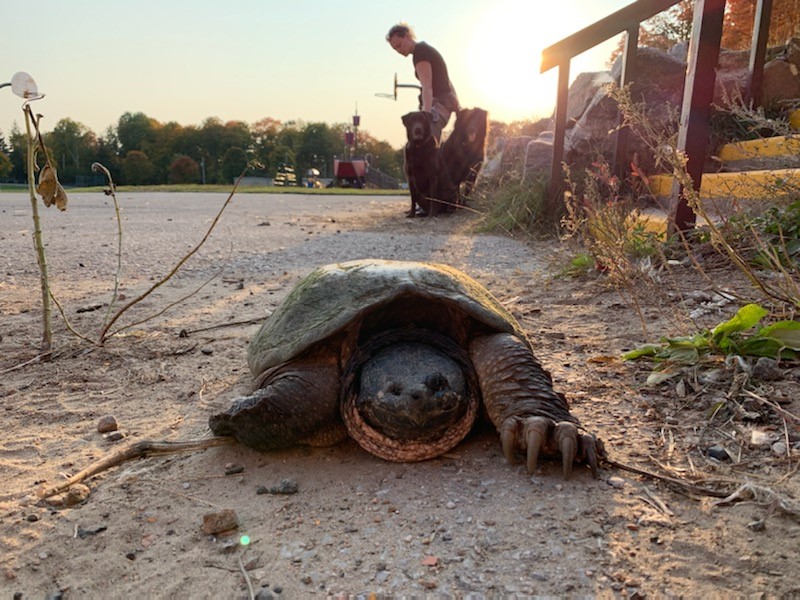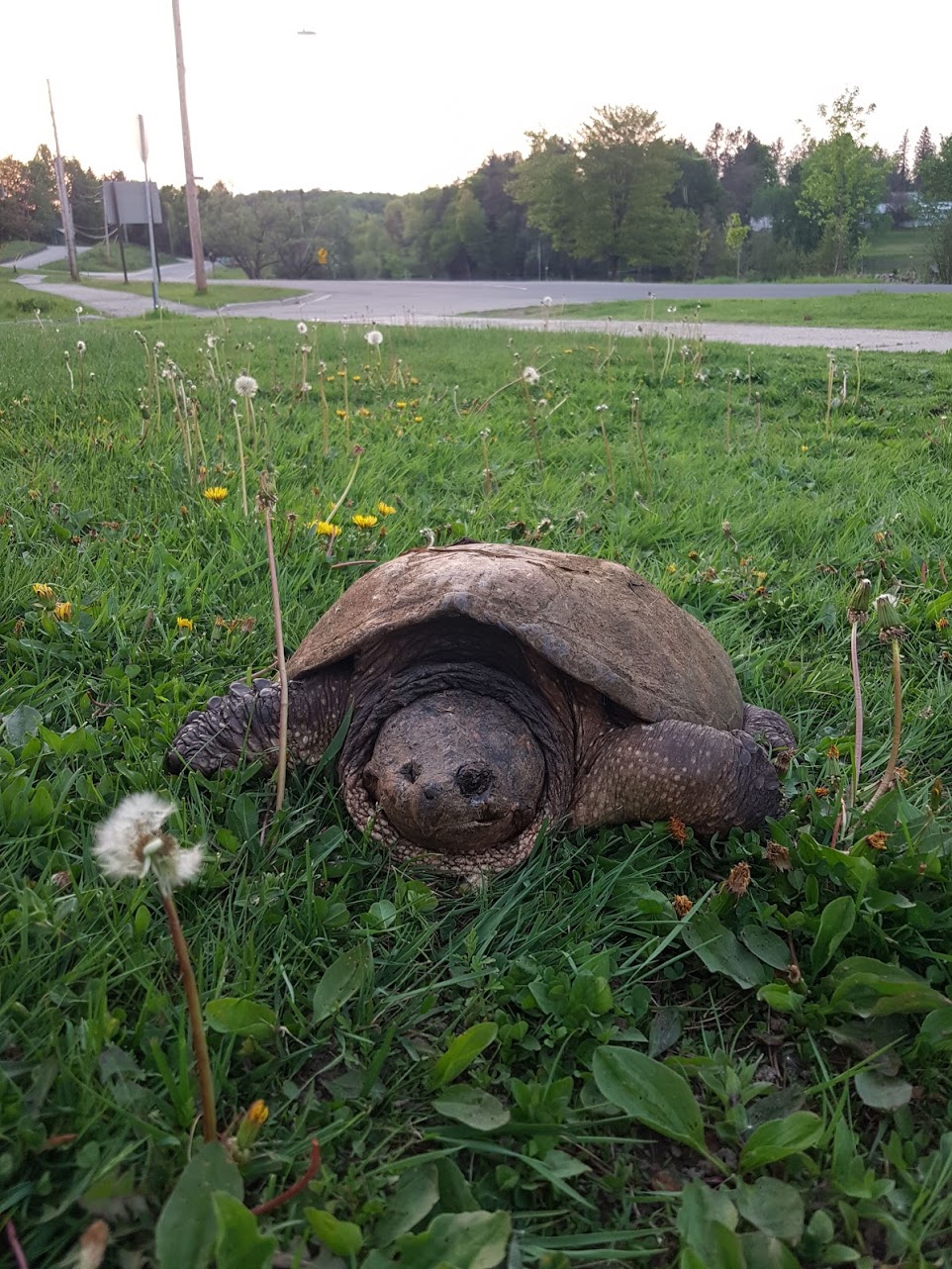
Poilievre vows to grant oil and gas industry’s entire wishlist
Conservative Leader Pierre Poilievre says he’ll fast-track approvals and scrap key rules that protect the...
On the first weekend of July, Karol Chorostecki and Stephanie Guiler were paddleboarding in Lake Koshlong in Haliburton County, Ont., when they spotted something odd deep in the water.
At first, they thought it was a large piece of plastic, maybe a laundry bag. They dove in, and pulled out a very large concave disk etched in distinctive geometric lines from the swampy lake bed near a dam. As they picked it up, they found other pieces scattered near it — “a trail of bones,” Chorostecki said, leading all the way to the lake’s coastline, where they found a skull that looked a bit strange: the left eye socket was much smaller than the other.
Guiler’s grandparents owned a cottage on this lake for more than 50 years, so the two of them had trekked here every summer and winter from London, Ont. They kept tabs on the area: a thriving ecosystem of endangered species, notably turtles, all kinds of turtles, living in ever-shrinking wetlands. Months ago, they had read a CBC story about Grace, the one-eyed snapping turtle, who is suspected to be at least 125 years old if not older — one of Ontario’s oldest female turtles, older than any living human being — who had been missing for over a year from her wetland in downtown Haliburton village on Lake Kashagawigamong.
As they put together the skeleton, Chorostecki and Guiler realized they had assembled “an upside-down turtle carcass.” Its size and the skull led to only one conclusion: “It was Grace,” they told The Narwhal.
The discovery was conclusive but it didn’t explain the circumstances of her death: how did Grace, a creature of habit, end up here, so far from her habitat? Did someone move her?


Chorostecki and Guiler called Leora Berman, founder of The Land Between and the Turtle Guardians program, both non-profit groups dedicated to protecting turtles and their habitats. Berman first met her in 2018 and has since watched out for Grace over four years, introducing her to the world.
When she received the remains, Berman and her team matched the bones with photos; they found matches on everything. The lines on the turtle shell matched the unique nodules and bumps they had recorded from their observations of Grace. The scale matched, the skull matched, the size matched. “I’ve been grieving for a long time but in that moment I felt forlorn,” Berman told The Narwhal.
Grace didn’t have to die. She could have lived a very long time. Snapping turtles can live more than 275 years, helping to pollinate wetlands and cleaning up lakes. The older and more mature the females get, the better they are able to reproduce and further their species, which is listed as one of special concern in Ontario. It takes about 60 years for a turtle to replace itself. That’s why adults as old as Grace are essential to preserve the population because the older they get, the more eggs they can produce.

Several people who have seen Grace or study and take care of turtles say her death is emblematic of the increasing and unaddressed threats to species at risk across Ontario — especially in the wake of recent legislation that threatens to further weaken protections of wetlands and other species habitats in favour of development.
Grace’s habitat has been under threat for the last few years. The wetlands where she routinely hibernated every winter have been gradually filled in recent years. Despite partly being designated as a municipal environmental protected area, photos taken by Berman show a bulldozer filling the land, which is now owned by a private landowner, with dirt in January 2022.
Environment Minister David Piccini had directed the provincial environment ministry to monitor the situation, telling The Narwhal last year that the property owner had agreed to stop the fill. A habitat assessment was requested.
The minister did not respond to questions sent by The Narwhal about Grace’s death. Neither did the owner of the property where Grace hibernated.
In an interview, Murray Fearrey, mayor of Drysart et al, the municipality in Haliburton county where Grace’s habitat is, said he was shocked to hear about her death but that there was not much the local government was doing or could have done to protect her.



“We kind of assumed she was where she always was,” he told The Narwhal. “It’s a loss. We obviously couldn’t do anything about it because we didn’t know where she was.” Her hibernation site, he said, couldn’t be protected because it was a swampy area on both sides of a road. He said it was always monitored by “turtle people” who served as “pretty good security for Grace.”
“Sure, I guess we can do more but where do we start? It’s not easy, trust me,” he said, adding that he had only learned how important turtles were to the ecosystem a few years ago.
This summer, a large part of Grace’s hibernation site looks like a perfect bed of grass, with very little water around for turtles or any species to move in or through. Over the years, the surrounding wetlands have also been overtaken by human spaces, too: football fields, parking lots, roads.
“She’s been a great ambassador for her species,” Berman said. “She’s been an icon, a legend, an attraction. She was part of our heritage. It’s a great, great loss.”

Despite being spotted in downtown Haliburton for over half a century, Grace’s remains weren’t found anywhere in her habitat. They were found more than 15 kilometres away from it, which has left many turtle experts perplexed.
“Finding dead turtles randomly in the national environment is not typical,” said Jeff Hathaway, founder of Scales Nature Park, a nature centre in the township of Oro-Medonte that is focused on Canadian reptile and amphibian conservation. “It happens but it’s very rare.”
“And, generally, when we see turtles that have been moved large distances, the immediate thought is that somebody moved it,” Hathaway said.
Snapping turtles like Grace are creatures of habit: they are slow creatures that stick to their home. They use the same nesting site and the same hibernation site. If they do have to move because the area no longer satisfies their needs, they’ll move within their habitat first and over many years they might move further away.



The last time someone confirmed seeing Grace alive in her home was in the summer of 2021. The next summer, Turtle Guardians received two reports of a one-eyed turtle: one in her habitat and one near the lake where her remains were found. The lake itself is nearly six kilometres long and two kilometres wide, and it wasn’t immediately clear whether the spotting was anywhere near where her body was found. But with no pictures sent to verify — and because the area was so far off Grace’s path — both reports of sightings from 2022 were dismissed.
But experts wonder how Grace could have travelled that far on her own so quickly. There are no waterways or connecting wetlands for her to travel through to Lake Koshlong, where her remains were found. The way there is steep, hilly and overland, full of roadways and very little natural cover from predators and cars.
“It’s unusual, if not impossible,” said Christina Davy, an assistant professor of biology at Carleton University who specializes in reptiles. Davy said that in rare instances turtles have been observed in rare cases to move close to 10 kilometres but over a long period of time. If her needs weren’t being met in her habitat, perhaps because of increased development, Grace could’ve moved.
“There’s so much unknown. Animals can do strange things and we don’t necessarily know everything about them,” Davy said. “But I am surprised, with the caveat that she’s been missing so we don’t know for sure.”


Scott Gillingwater, a species at risk biologist and herpetologist with Upper Thames River Conservation, agrees that the distance is “very odd for a snapper,” and suspected relocation is the most likely explanation. That is concerning because moving turtles can disrupt the ecosystem: if there’s no access to food or risk of disease, both the turtle and the species around them could be harmed.
“But there’s no way to stop relocation,” he said. “It’s hard to track and impossible to enforce.”
Gillingwater adds that the fact her remains were found in one place suggests she wasn’t killed by a predator. She was too big to be carried off by a bird, and if she was attacked by one, her remains would be scattered all over the area.
The community of Haliburton County may not ever fully know what happened to Grace, but will honour the end of her story with a memorial walk in September, organized by Turtle Guardians. Berman remains concerned about the impacts of development on the turtle-rich habitat she helps monitor.
“We can fly to the moon and we can find cures for diseases. We can invent the atomic bomb as well as all kinds of other things. And yet, we can’t find a balance in terms of conservation and development,” she said.
Grace’s death is a reminder of that dichotomy for the community. Some still point to all the places they spotted her: the school yard, behind the hospital, on the side of the road, on their deck. But for now, her remains are in Berman’s home, in a box with a piece of tobacco. An Indigenous Elder gave the tobacco to Berman so the ancient turtle could be at rest until a proper burial can be held.
“It was by grace that she survived all these years with one eye,” Berman said. “And it’s by grace that we found her remains.”
Get the inside scoop on The Narwhal’s environment and climate reporting by signing up for our free newsletter. On March 17, federal Conservative Leader Pierre Poilievre...
Continue reading
Conservative Leader Pierre Poilievre says he’ll fast-track approvals and scrap key rules that protect the...

One LNG project alone is requesting more than half the amount of electricity B.C.’s Site...

In Georgian Bay, First Nations youth are coming together over hide tanning, language lessons and...
